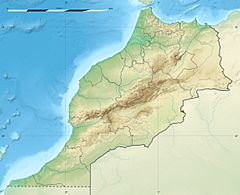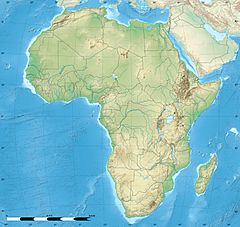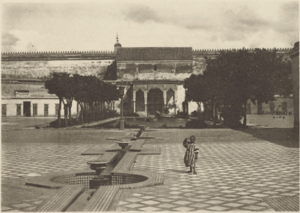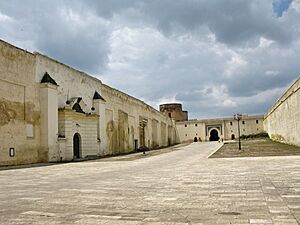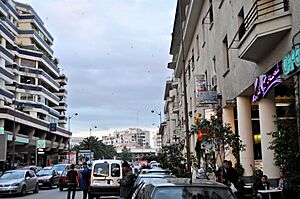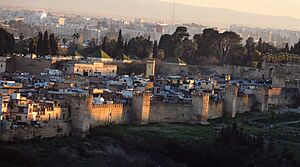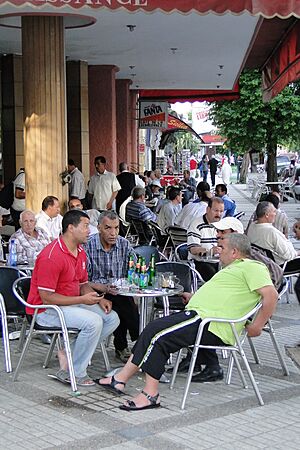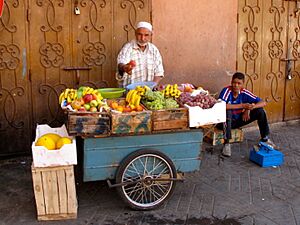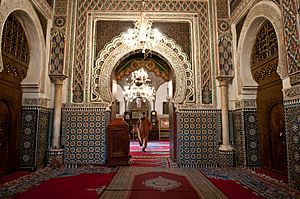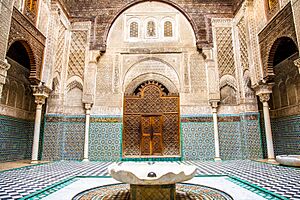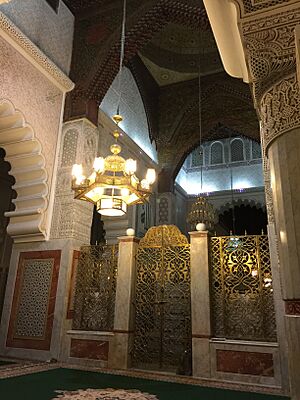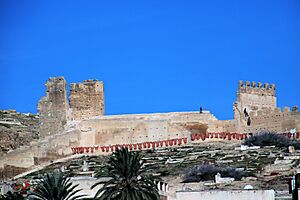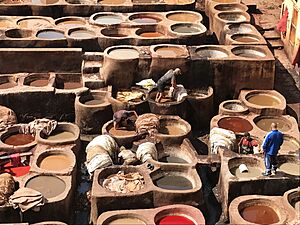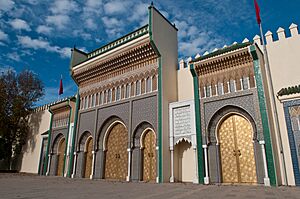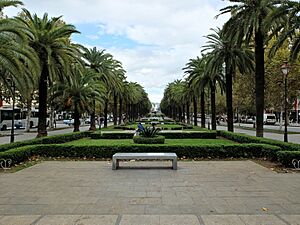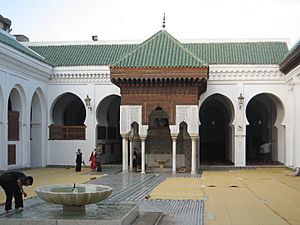Fez, Morocco facts for kids
Quick facts for kids
Fez
فاس
|
|
|---|---|
|
From the top down:
Al-Qarawiyyin Mosque/University, gates of the Royal Palace, and Fes el Bali a.k.a. the Medina of Fez. |
|
| Country | |
| Region | Fez-Meknes |
| Founded | 789 |
| Founded by | Idrisid dynasty |
| Area | |
| • Urban | 320 km2 (120 sq mi) |
| Elevation | 414 m (1,358 ft) |
| Population
(2014)
|
|
| • City | 1,112,072 |
| • Rank | 2nd in Morocco |
| • Demonym | Fessi |
| Time zone | UTC+1 (CET) |
| Area code(s) | +212 (53) |
| Official name: Medina of Fez | |
| Type: | Cultural |
| Criteria: | iii, iv |
| Designated: | 1981 |
| Region: | Arab States |
Fez, also spelled Fes, is a large city in northern Morocco. It is the capital of the Fez-Meknes region. With over 1.1 million people in 2014, it is the second-largest city in Morocco. Fez is located near the Atlas Mountains and is surrounded by hills. The old part of the city is built around the Fez River.
Fez is known as the "Mecca of the West" and the "Athens of Africa." It is also seen as the spiritual and cultural heart of Morocco. The city was founded in the 8th and 9th centuries CE. Early settlers included Arab immigrants from Tunisia and Spain, which gave the city its Arab feel.
In the 11th century, the two original settlements of Fez were united. This created what is now known as Fes el Bali, or "Old Fez." The city became famous for its religious learning and trade. Fez was most important during the Marinid era (13th–15th centuries). During this time, it was the political capital again. Many beautiful schools (madrasas) and mosques were built or fixed up. These buildings show off the amazing Moorish and Moroccan styles.
In 1276, a new area called Fes Jdid ("New Fez") was built. This is where the Royal Palace is located. The Jewish community in Fez also grew, and the Mellah (Jewish quarter) was formed in this new district. Fez was the capital again until 1912.
Today, Fez has two old city parts, Fes el-Bali and Fes Jdid. It also has a much larger modern area called Ville Nouvelle (New City). The Medina of Fez is a World Heritage Site. It is one of the world's largest and oldest car-free areas. It is home to the University of al-Qarawiyyin, founded in 857. This is the oldest university that has been open continuously in the world. The city also has the Chouara Tannery, an 11th-century leather workshop, which is one of the oldest tanneries in the world.
Contents
What's in a Name?
The city's name in Arabic is Fās. This is where the English names Fez and Fès come from. Some stories say the name comes from the Arabic word Faʾs, meaning "pickaxe." One legend says a gold pickaxe was found when the city was being built. Another story says Idris I, who founded the city, used a silver and gold pickaxe himself.
For a while, Fez was actually two separate cities. One was called Fās, founded by Idris I. The other was al-ʿĀliyá, founded by his son, Idris II. The capital was known as al-ʿĀliyá. In 1070, the two cities joined together. From then on, the whole city was called Fās.
A Look Back at Fez's History
How Fez Began

The city started in 789 as Madinat Fas. It was built by Idris I, who founded the Idrisid dynasty. His son, Idris II, built another settlement called al-ʿĀliyá in 809. He made it his capital. At first, most people were Berbers, along with Arab warriors.
More Arab people moved to Fez later. Families from Spain, who were expelled after a rebellion in 817–818, settled in Madinat Fas. These groups helped give the city its Arab culture. Fez also had a strong Jewish community. They lived mainly in a part of al-ʿĀliyá.
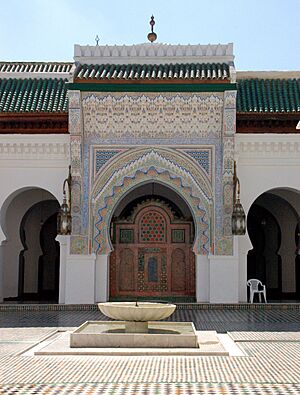
After Idris II died in 828, his sons fought over the region. The city faced many changes in power during the 10th century. Different groups, like the Umayyad Caliphate and the Fatimid Caliphate, controlled it.
Fez continued to grow, even with conflicts between its two parts. A ruler named Dunas ibn Hamama (1037–1049) improved the city's water system. He also built bathhouses and mosques. The two cities became more connected with new houses and bridges.
Major Dynasties and Their Impact
In 1069–1070, the Almoravids conquered Fez. Their leader, Yusuf ibn Tashfin, united the two parts of the city into one. He tore down the old walls and built new ones around the whole city. Even though the capital moved to Marrakesh, Fez remained important for trade and learning. Yusuf ibn Tashfin is sometimes called the second founder of Fez.
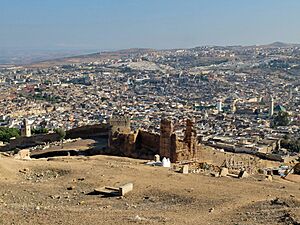
In 1145, the Almohads took over Fez. They destroyed the city's defenses at first. But because Fez was so important, they rebuilt the walls. These walls still define Fes el-Bali today. By the 12th century, Fez was one of the world's largest cities, with about 200,000 people.
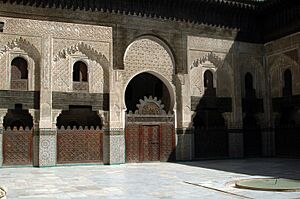
Fez became the capital again in 1250 under the Marinid dynasty. This was a "golden age" for the city. In 1276, the Marinid sultan Abu Yusuf Yaqub founded Fes Jdid as a new government and military center. Many schools (madrasas) were built, showing off beautiful Moroccan architecture.
The Jewish quarter, called the Mellah, was created in Fes Jdid during this time. Jewish people moved there, especially after being expelled from Spain and Portugal in the late 1400s.
Later, the Wattasids ruled from Fez. In the 16th century, the Saadis took power. They built new forts around Fez to control the city.
The city saw a new beginning when Moulay Rashid of the 'Alawi dynasty took Fez in 1666. He restored the city and built new military camps. However, his successor, Moulay Isma'il, moved the capital to Meknès. Fez suffered from conflicts for decades after.
Fez regained its importance under Moulay Muhammad ibn Abdallah (1757–1790). It remained the capital until the 20th century. The 'Alawis continued to build and restore monuments. The Tijani Sufi order, a religious group, made Fez its spiritual center. Until the 19th century, Fez was the only place that made the famous fez hat.
The last big change to Fez before the 1900s was made by Sultan Moulay Hassan I. He connected Fes Jdid and Fes el-Bali with a walled path. New gardens and palaces were built along this path.
Fez in Modern Times
In 1912, French colonial rule began in Morocco. The French decided to move the capital to Rabat. They also chose to keep the old cities, like Fez, as historic sites. Instead, they built new, modern cities, called Villes Nouvelles (New Cities), outside the old ones. This helped preserve the old medina but also created a separation between the old and new parts of the city.
Fez was important in the Moroccan nationalist movement. Many leaders studied at the Al-Qarawiyyin University. People in Fez protested against French rule. After World War II, Moroccan nationalists in Fez demanded independence.
After Morocco became independent in 1956, many wealthy people moved to Casablanca and Rabat. The Jewish population also largely left. However, Fez continued to grow and became the second-largest city in Morocco by 2000. In 1981, the old city of Fez was named a World Heritage Site by UNESCO.
Today, Fez is still a major city and a popular tourist spot. Efforts are being made to restore and improve the old medina.
Geography and Climate
City Layout
Fez is divided into its historic medina (the old walled parts of Fes el-Bali and Fes Jdid) and the much larger modern Ville Nouvelle (New City). The old city is in a valley along the Fez River. This river splits into small canals that bring water to the historic city.
The new city is on a flat area called the Saïs plain. This plain is mostly farmland. The main airport, Fes-Saïs, is about 15 km south of the old city.
Weather in Fez
Fez has a hot-summer Mediterranean climate. This means it has cool, wet winters and dry, hot summers. Rainfall can be up to 800 mm in good years. In winter, temperatures are around 15°C during the day and 4.5°C at night. Frost can happen. In summer, temperatures reach about 34.5°C during the day and 18°C at night. Snowfall happens about once every 3 to 5 years.
| Climate data for Fez (Fès–Saïs Airport), altitude: 579 m (1,900 ft) 1991–2020 | |||||||||||||
|---|---|---|---|---|---|---|---|---|---|---|---|---|---|
| Month | Jan | Feb | Mar | Apr | May | Jun | Jul | Aug | Sep | Oct | Nov | Dec | Year |
| Record high °C (°F) | 25.4 (77.7) |
30.5 (86.9) |
33.3 (91.9) |
37.8 (100.0) |
41.3 (106.3) |
44.0 (111.2) |
46.7 (116.1) |
45.7 (114.3) |
42.8 (109.0) |
37.5 (99.5) |
32.3 (90.1) |
27.0 (80.6) |
46.7 (116.1) |
| Mean daily maximum °C (°F) | 16.0 (60.8) |
17.3 (63.1) |
19.9 (67.8) |
22.0 (71.6) |
26.4 (79.5) |
31.2 (88.2) |
35.1 (95.2) |
35.1 (95.2) |
30.3 (86.5) |
26.1 (79.0) |
20.2 (68.4) |
17.2 (63.0) |
24.7 (76.5) |
| Daily mean °C (°F) | 9.9 (49.8) |
10.9 (51.6) |
13.3 (55.9) |
15.2 (59.4) |
19.0 (66.2) |
23.1 (73.6) |
26.5 (79.7) |
26.8 (80.2) |
22.9 (73.2) |
19.4 (66.9) |
14.1 (57.4) |
11.2 (52.2) |
17.7 (63.9) |
| Mean daily minimum °C (°F) | 3.7 (38.7) |
4.4 (39.9) |
6.6 (43.9) |
8.3 (46.9) |
11.5 (52.7) |
14.9 (58.8) |
17.9 (64.2) |
18.3 (64.9) |
15.6 (60.1) |
12.6 (54.7) |
8.1 (46.6) |
5.2 (41.4) |
10.6 (51.1) |
| Record low °C (°F) | −8.2 (17.2) |
−5.3 (22.5) |
−2.5 (27.5) |
−0.5 (31.1) |
0.0 (32.0) |
4.9 (40.8) |
8.5 (47.3) |
9.2 (48.6) |
5.9 (42.6) |
0.0 (32.0) |
−1.4 (29.5) |
−5.0 (23.0) |
−8.2 (17.2) |
| Average precipitation mm (inches) | 60.1 (2.37) |
54.3 (2.14) |
59.2 (2.33) |
54.7 (2.15) |
38.2 (1.50) |
11.1 (0.44) |
1.1 (0.04) |
4.9 (0.19) |
22.1 (0.87) |
53.9 (2.12) |
66.1 (2.60) |
62.0 (2.44) |
487.7 (19.20) |
| Average precipitation days | 6.7 | 6.5 | 6.9 | 6.3 | 4.7 | 1.7 | 0.4 | 1.0 | 2.4 | 5.1 | 6.5 | 6.5 | 54.7 |
| Mean monthly sunshine hours | 210.6 | 201.1 | 244.0 | 246.5 | 278.0 | 315.0 | 338.0 | 320.4 | 282.5 | 245.5 | 205.2 | 199.8 | 3,086.6 |
| Percent possible sunshine | 60 | 55 | 58 | 62 | 64 | 71 | 79 | 77 | 75 | 64 | 60 | 60 | 65 |
| Source 1: NOAA (sun 1981–2010) | |||||||||||||
| Source 2: Voodoo skies for extremes, Weather AtlasJanuary record high | |||||||||||||
| Climate data for Fez | |||||||||||||
|---|---|---|---|---|---|---|---|---|---|---|---|---|---|
| Month | Jan | Feb | Mar | Apr | May | Jun | Jul | Aug | Sep | Oct | Nov | Dec | Year |
| Mean daily daylight hours | 10.0 | 11.0 | 12.0 | 13.0 | 14.0 | 14.0 | 14.0 | 13.0 | 12.0 | 11.0 | 10.0 | 10.0 | 12.0 |
| Average Ultraviolet index | 3 | 4 | 6 | 8 | 9 | 10 | 11 | 10 | 8 | 6 | 4 | 3 | 6.8 |
| Source: Weather Atlas | |||||||||||||
People and Languages
In 2014, Fez had over 1.1 million people. Most of them were Moroccan. There were also about 3,500 foreign residents. The main religion in Fez is Islam. In the past, Fez had a large Jewish community. Today, fewer than 200 Jewish people remain.
The main language spoken in Fez is Darija. This is a local version of Arabic. People from old, important families in Fez speak a special Fessi dialect. This dialect was once seen as very proper. However, due to changes in the city, these old language features are not as common today.
Modern Standard Arabic and Berber are Morocco's two official languages. French is also widely used in government and law. Many people in Fez speak French well. English is becoming more popular among young people. Berber dialects are common in the countryside around the city.
Fez's Economy
Historically, Fez was a major center for trade and crafts in Morocco. The tanning industry, which makes leather, has been important since the city's early days. The famous tanneries in Fes el-Bali still operate today. Until the late 1800s, Fez was the only place in the world that made the fez hat. The city's trade happened along its main streets and in its central markets.
Today, the land around Fez is used for farming. Farmers grow cereals, beans, olives, and grapes. They also raise livestock. Tourism is a big industry because of the city's historic medina, which is a UNESCO World Heritage Site. Many people visit the city for religious reasons too. They come to see the shrines of Islamic saints.
Famous Landmarks
The Historic Medina
The historic city of Fez has two main parts: Fes el-Bali and Fes Jdid. Fes el-Bali is the original city. Fes Jdid was built later in the 13th century. These two old cities are connected and are usually called the "medina" of Fez. Fes el-Bali is the oldest continuously lived-in walled city in the Arab world. It is also one of the largest car-free areas in the world.
The famous University of al-Qarawiyyin is in Fes el-Bali. The Zawiya of Moulay Idris II, an important religious site, is also there. Fez Jdid is home to the huge Royal Palace, which is still used by the King of Morocco.
Fez is a popular place for tourists. Many people are restoring traditional houses, called riads, to use as homes or hotels. In 1981, UNESCO named the Medina of Fez a World Heritage Site. They called it "one of the most extensive and best conserved historic towns of the Arab-Muslim world." It was the first place in Morocco to get this special status.
Places of Worship
The medina has many historic mosques. Some of the oldest ones still standing are the Mosque of al-Qarawiyyin, founded in 857, and the Mosque of the Andalusians, founded in 859–860. The Bou Jeloud Mosque is from the late 12th century.
Many mosques were built during the Marinid era. These include the Great Mosque of Fez el-Jdid (1276) and the Chrabliyine Mosque (1342). Later, the 'Alawi dynasty built mosques like the Moulay Abdallah Mosque and the R'cif Mosque. The Ville Nouvelle also has many modern mosques, like the Imam Malik Mosque.
The Jewish quarter (Mellah) has the 17th-century Al-Fassiyin Synagogue and Ibn Danan Synagogue. While there are other synagogues, none are currently in use. The Church of Saint Francis of Assisi is the only Catholic church in Fez. It was built in 1928 during the French colonial period.
Historic Schools (Madrasas)
The University of al-Qarawiyyin was started in 857 by Fatima al-Fihri as a mosque. It is now a university. It is considered the oldest continuously operating university in the world. The Marinid dynasty built many madrasas (religious schools). These schools are some of the best examples of Moroccan architecture.
The first madrasa built by the Marinids was the Saffarin Madrasa in 1271. Other important ones include the Al-Attarine Madrasa and the Bou Inania Madrasa. The library of al-Qarawiyyin, which has many old manuscripts, was also started during the Marinid rule around 1350. It is believed to be the oldest library still open today. The largest madrasa in the medina is Cherratine Madrasa, built in 1670.
Tombs and Shrines
The Zawiya of Moulay Idris II is in the heart of Fes el-Bali. It is a shrine and religious complex dedicated to Idris II, who is seen as the main founder of Fez. Another important shrine is the Zawiya of Sidi Ahmed al-Tijani. It honors Sidi Ahmed al-Tijani, who started the Tijaniyyah religious group.
Fez has several large historic cemeteries outside the old city walls. These include the cemeteries of Bab Ftouh, Bab Mahrouk, and Bab Guissa. Some have domed buildings called marabouts, which hold the tombs of local Muslim saints. The ruins of the Marinid Tombs, built in the 14th century for Marinid sultans, are near the Bab Guissa Cemetery.
City Walls and Forts
The medina of Fez was strongly protected by walls with towers and gates. The oldest parts of these walls are from the Almohad period. The gates were guarded and closed at night. Some main gates, like Bab Mahrouk, Bab Guissa, and Bab Ftouh, have been there since the city's early days. In modern times, gates like the decorative Bab Bou Jeloud (built in 1913) are more for show than defense.
Throughout history, 13 forts (called kasbahs) were built around the city. These include the Kasbah an-Nouar and the Kasbah Cherarda. In the late 16th century, the Saadis built strongholds like Borj Nord and Borj Sud to oversee the city.
Famous Tanneries
The tanning industry has been active in Fez since the city was founded. It is now a major tourist attraction. The largest tannery is Chouara Tannery, located near the Saffarin Madrasa. The tanneries have many round stone wells filled with colorful dyes or liquids to soften animal hides. The leather goods made here are sold all over the world. There are two other large tanneries: the Sidi Moussa Tannery and the Ain Azliten Tannery.
Palaces and Homes
Many old private homes have survived in Fez. A traditional house, called a dar, is built around an inner courtyard. Some larger homes also have internal gardens, known as riads. Many of these traditional houses are now used as hotels for tourists.
Fez also has several royal palaces. The Dar Batha is a former palace that became a museum in 1915. It holds about 6,000 pieces of historical art. A large part of Fes Jdid is taken up by the 80-hectare Royal Palace, or Dar al-Makhzen. Its fancy gates are the main part visitors can see. The palace grounds are not open to the public, as the King of Morocco still uses them.
Gardens and Green Spaces
The Jnane Sbile Garden, located between Fes Jdid and Fes el-Bali, is the oldest garden in Fez. It was created as a royal park in the 19th century. Many wealthy homes also had private gardens. Other gardens are found within the royal palaces, like the Agdal and Lalla Mina Gardens.
Fez has limited green spaces compared to international standards. However, there are some notable parks. Latin American Park, opened in 2015, is a 3,700 square meter park in the city center. It has a pool, a children's area, and cafes. The Bird Park, or Tropicana Park, is another green area. It is over seven acres and has playgrounds, restaurants, and a "Bird Garden" with over thirty species of birds.
Historic Merchant Buildings (Funduqs)
The old city of Fez has over a hundred funduqs (also called foundouks). These were traditional inns or large buildings for merchants. They housed workshops and offered lodging for traders and travelers. They were also used for markets and auctions. The Funduq al-Najjarin, built in the 18th century, now houses a museum of wooden arts and crafts.
Public Bathhouses (Hammams)
Fez has many historic hammams (public bathhouses) that are still used today. Examples include the Hammam as-Saffarin and the Hammam Ben Abbad, both from around the 14th century. Hammams usually have a changing room, a cold room, a warm room, and a hot room. Their domes and vaults can be seen from outside.
The New City (Ville Nouvelle)
The Ville Nouvelle (New City) is built around Avenue Hassan II. This wide street was created by the French colonial government after 1912. It has a tree-lined park in the middle. Many of the city's public buildings were built along this avenue during the colonial period. These buildings mix different styles, including Moroccan, Art Deco, and Neoclassical.
Culture and Arts
Fez is seen as the spiritual and cultural heart of Morocco. It is often called the "Mecca of the West" and the "Athens of Africa."
Literature and Books
The University of al-Qarawiyyin was the center of learning in Fez for a long time. Literature focused on religious studies, philosophy, and poetry. The largest library was at the Qarawiyyin Mosque. In the 19th century, wealthy families started their own private libraries.
Fez is also a historical center for Sufism, a mystical branch of Islam. Many writings were about Sufi saints and teachers. These writings helped show Fez as a center of spiritual heritage.
In the early 20th century, Moroccan literature became more varied. Political writings became common. For example, some works called on Moroccans to unite against European influence.
The first book printed in Africa was in Fez. It was a Hebrew book called Sefer Abudarham, printed in 1516 by Jewish refugees from Lisbon. Printing in Arabic started in Morocco in 1864–65, with the first Arabic book printed in Fez in 1865.
Visual Arts
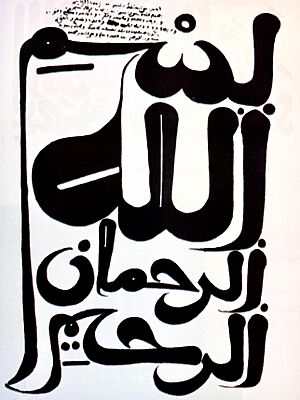
Maghrebi Arabic script is an important part of Fez's visual art history. Calligraphers like Muhammad al-Qandusi created unique styles.
Fez is the most important place in Morocco for making zellij, which is traditional mosaic tilework. Workshops in other cities often copy the style of Fez.
Music
Fez is known for the āla musical style. This style came from Muslims who moved from Valencia, Spain, to Fez. The Fessi āla style uses Moroccan forms of old melodical arrangements.
Cultural Places
The city's main museums are in historic buildings, like the Nejjarine Museum and the Dar Batha Museum. The Al Houria Cultural Complex, opened in 2005, has a theater and exhibition spaces. Language institutes like the French Institute and the Cervantes Institute also offer cultural activities.
Festivals and Celebrations
Fez hosts the yearly World Sacred Music Festival, which began in 1994. It features religious music from all over the world. The festival happens in May or June. Concerts take place at historic sites, like Bab Makina. The annual Festival of Amazigh Culture celebrates Berber music and art. The Festival of Sufi Culture has talks and music about Sufism. The Festival of Malhoun Art showcases traditional Moroccan music and poetry.
Many moussems (Sufi religious festivals) are held each year to honor local Muslim saints. The most important one is the Moussem of Moulay Idris II. This festival has been held for hundreds of years. All the city's guilds march together to the mausoleum of Idris II. They bring gifts to the shrine, including a large decorated textile called a keswa.
The Fez Running Festival is a race that started in 2022. It has races for both kids and adults. Thousands of people participate each year.
Sports in Fez
Fez has two main football teams: MAS Fez and Wydad de Fès. They both play in the Botola, Morocco's top football league. Their home games are played at the 45,000-seat Complexe Sportif de Fès stadium.
Fez is expected to host matches for the 2030 FIFA World Cup and the 2025 Africa Cup of Nations. The stadium will be upgraded for these events. The MAS Fez basketball team plays in Morocco's top basketball division.
City Services
Parks and Recreation
Fez has limited green spaces. However, there are some nice parks. Latin American Park, opened in 2015, is a park in the middle of Fez. It has a pool, a children's area, and cafes. The Bird Park, or Tropicana Park, is another green area. It has playgrounds, event spaces, and a "Bird Garden" with over thirty types of birds.
Getting Around Fez
The city is served by the Fès–Saïs international airport, located about 15 km south of the city center. A new terminal was added in 2017.
The city's main train station is near the downtown area of the Ville Nouvelle. It connects Fez to other cities like Oujda, Tangier, and Casablanca. The main intercity bus terminal is just north of Bab Mahrouk, outside the old medina. Intercity taxis also operate from several locations.
Fez has a public bus system with various routes for getting around the city.
Water and Electricity
The city's water, sewage, and electricity are managed by the Water and Electricity Distribution Authority of Fez. Since 2014, a special plant has been treating Fez's wastewater.
Learning in Fez
Education in Fez is managed by Morocco's Ministry of National Education. It includes preschool, six years of primary school, and six years of secondary school. Primary education is free and required starting at age six. Vocational training is also available.
Fez's University of al-Qarawiyyin is thought to be the oldest continuously operating university in the world. It started as a mosque in 859 and became a state university in 1963.
Sidi Mohamed Ben Abdellah University is a public university founded in 1975. It is the largest in the city, with over 86,000 students in 2020. It has 12 faculties across Fez. The Euro-Med University of Fez, another public university, was created in 2012. The Private University of Fez was founded in 2013. It focuses on engineering, architecture, business, and law.
Fez and Other Cities
Fez is twinned with many cities around the world:
 Bobo-Dioulasso, Burkina Faso (1982)
Bobo-Dioulasso, Burkina Faso (1982) Chengdu, China (2015)
Chengdu, China (2015) Coimbra, Portugal
Coimbra, Portugal Córdoba, Spain (1990)
Córdoba, Spain (1990) East Jerusalem, Palestine (1982)
East Jerusalem, Palestine (1982) Florence, Italy (1961)
Florence, Italy (1961) Jericho, Palestine (2014)
Jericho, Palestine (2014) Kairouan, Tunisia (1965)
Kairouan, Tunisia (1965) Kraków, Poland (1985)
Kraków, Poland (1985) Montpellier, France (2003)
Montpellier, France (2003) Saint-Louis, Senegal (1979)
Saint-Louis, Senegal (1979) Suwon, South Korea (2003)
Suwon, South Korea (2003) Wuxi, China (2011)
Wuxi, China (2011) Xi'an, China (2019)
Xi'an, China (2019)
Famous People from Fez
- Abd al-Hafid of Morocco – Sultan of Morocco (1909–1912)
- Abdellatif Laabi – Poet
- Abderrahime Bouramdane – Professional marathon runner
- Adel Taarabt – Football player
- Anas Zniti – Football player
- Dunash ben Labrat – Poet and commentator
- Jilali Gharbaoui – Modernist artist
- Mehdi Bennani – Professional racing driver
- Princess Lalla Salma of Morocco – Princess consort of Morocco
- Rachid Yazami – Scientist, engineer, and inventor
- Soufiane El Bakkali – Steeplechase runner
- Touria Chaoui – First female Moroccan pilot
- Youssef En-Nesyri – Football player
Images for kids
-
A page from a 16th-century manuscript of Rawḍ al-Qirṭās, a book about the history of Fes under different dynasties.
-
A painting of the 17th century expulsion of the Moriscos from Valencia.
-
The Sufi calligrapher and scholar Muhammad Bin Al-Qāsim al-Qundūsi (d. 1861) developed his unique calligraphic style in Fes.
See also
 In Spanish: Fez para niños
In Spanish: Fez para niños





